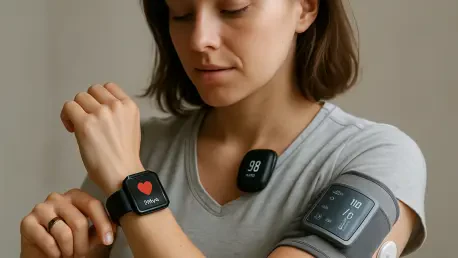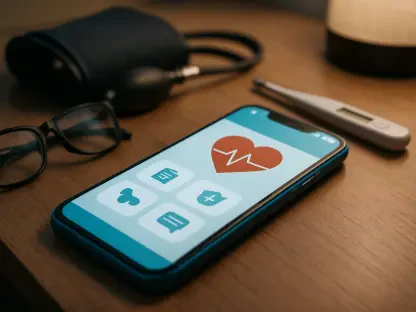The way people think about health has changed a lot over the last ten years. They don’t just go to the doctor and get checked once a year like they used to. Now, healthcare is literally in everyone’s hands, pockets, arms, and even fingers. Wearable technology has been developed to help people protect their health and well-being in new ways. These devices, now ranging from watches to rings and glasses, are not just about counting how many steps people walk daily. They can detect heart problems, help with stress management and chronic illnesses, and offer early warnings that can actually save lives.
This change is important not only because of the new technologies developed in the process, but also because they have changed the way patients, doctors, and care providers interact. A device on your wrist can warn you if your heart is in trouble or tell you how to breathe better to reduce stress at work. Wearables are reshaping healthcare and taking it out of the doctor’s office, making it proactive, easier to use, and an integral part of people’s daily lives. As sensors get better and better, and AI technologies evolve, wearable tech is not just changing the healthcare industry—it is changing what it means to be healthy. Read on to discover how.
Preventive Care: Finding the Problem Before it Causes Damage
One of the most important things wearable tech does well is in the area of detecting problems before they happen. In the past, early signs of serious conditions like strokes or heart attacks were often missed until it was too late. Now, AI technologies help wearables analyze body signals in real-time, finding small changes that could have been missed before.
Take the Circular Ring 2 as an example. This small device is now equipped with new sensors that give better readings. It is also one of the first smart rings to give on-finger electrocardiogram readings and FDA-approved atrial fibrillation detection. To sum up, it delivers hospital-level checks on a device that is just as big as a wedding band. It can detect irregular heartbeats or sudden changes in vitals, providing both users and doctors with an important jump start.
Living with a Chronic Condition: from Watching and Waiting to Making Changes that Matter
Chronic illnesses like diabetes, asthma, and high blood pressure need constant care. In the past, managing these problems meant adopting daily routines, watching and waiting, and going to the doctor often. Today, wearable tech makes it easy to continuously monitor these conditions, and more than that, it can provide smart tips based on these readings.
For example, a person with diabetes can now use a wearable that monitors glucose levels all the time. That person will get a warning if and when sugar levels fluctuate. But that is not all. The app on their smartphone might even provide the patient in question with a snack idea or an exercise idea to balance the body’s insulin level.
According to a recent study, “wearable health devices are becoming vital in chronic disease management because they offer real-time monitoring and personalized care.” These devices can help people make better choices for their health and well-being.
Smartglasses and Smart Rings: The Next Frontier
Although smartwatches and bracelets have led the way in wearable tech, smart glasses and smart rings are gaining momentum. Because of their features and smaller size, they may even alter everyone’s perception of wearables.
Smartglasses, for example, are turning into mini displays for real-time biometrics. Future updates could include heart rate, stress, or blood oxygen saturation. At the same time, smart rings like Circular Ring 2 or Oura Ring are taking the lead in sleep and readiness monitoring. These tools are the next step in wearable technology—not only for what they do, but also for how they look.
Mental Health Help: Monitoring the Immeasurable
Mental health problems might not show up on a blood test, but they do have clear signs—if you can find them. Wearables are getting better and better at detecting these symptoms by monitoring heart rate variability, sleep patterns, and stress levels.
Tools like Apollo Neuro take this even further. They are called “novel touch therapy” devices, meaning that Apollo uses small vibrations that are meant to calm the nervous system. It comes with big claims: from improving sleep and attention to lowering PTSD. Still, critics show that, if it were a pill, Apollo Neuro would not get a green light from the FDA, according to recent tests. However, there are personal stories, reviews, and tests that do show promise for the future.
Health and Fitness Sensors: The Power of Change
At the core of wearable technology advancement is a group of sensors that can accurately monitor health information. These sensors—measuring heart rate, blood oxygen saturation, temperature, and the cycles of sleep—are getting better and less costly as time passes.
This change is helping push new ideas across the industry. A fitness tracker that now costs less than $100 may be as good as a high-priced smartwatch launched three years ago. This makes health tracking widely available, helping people everywhere take their health into their own hands.
Even more exciting is the use of multi-sensor arrays, where wearables cross-reference different data points for more accurate information. For example, users can now combine heart rate data, oxygen levels, and movement patterns to obtain a clearer image of sleep or stress cycles.
Final Thoughts: A New Age of Wearable Technology
Wearable tech has grown from simply tracking how people move to providing users with useful tools to help prevent and manage illnesses, maintain mental health, and promote well-being. The pairing of AI technologies with new sensors has opened up a new way for care to become personalized, active, and always available.
Human bodies can interact with smart devices that notify users about potential problems before they even get sick: when a smart ring, watch, or a pair of glasses can pick up a sign no one else can see; when mental health can be monitored as effectively as blood pressure, and when vibrations on people’s wrists and ankles can be used to alleviate stress.
Still, some problems remain. Data privacy, regulatory oversight, and user trust are important factors to consider when it comes to developing wearable technology. But, with new ideas and careful work, wearable tech providers can revolutionize the industry by changing how people take care of themselves.









